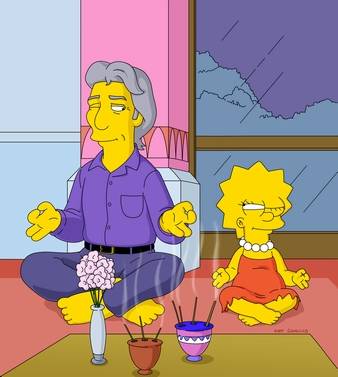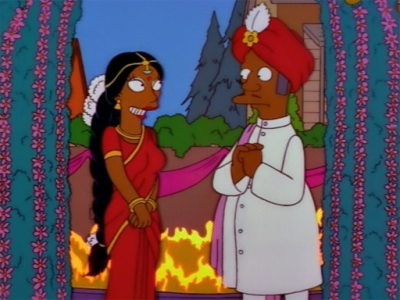The 10 Most Significant, Lasting Changes on The Simpsons
 |
?Cartoons have several advantages over live-action shows, but one of the most important isd this: the characters don’t have to age. Not only does this ensure audiences watch the same characters they love every single episode, year after year, it’s also particularly appealing to the syndication market. No matter what episode airs, no matter when it airs, it doesn’t require the viewer to have seen the previous episodes to follow what’s going on.
There’s an obvious downside to this, however — when everything needs to return to normal at the end of every episode, characters don’t grow. The Simpsons has poked fun at its tendency to return to the status quo on numerous occasions (Armin Tamzarian, anyone?). But throughout the show’s two-decades-long history, there have also been a few major changes that actually stuck and, in many cases, became important aspects of the characters. Here are the 10 most significant ones.
10) Barney’s Sobriety
 |
?After discovering his friends don’t respect him due to his alcoholism, town drunk Barney finally decides to sober up — and take helicopter lessons, no less. When sober, Barney’s hair is slicked back and his overall appearance is more groomed. Barney remained sober through the end of the episode and remained consistently so for a while afterward, but eventually he appeared drunk again. Ever since, he has appeared at times sober and at times drunk, depending on which is best for the episode — many writers were against the idea of him sobering up, as they felt it made him less funny. Due to the off-and-on nature of this change, it ranks as #10. (“Days of Wine and D’oh’ses,” 2000)
9) Nedna
 |
?The newest change in the list, the budding relationship between Ned Flanders and Edna Krabappel was cemented in the current season after fans voted to keep them together — forever — as an item. The vote’s outcome was confirmed in the episode “The Falcon and the D’ohman” where Ned and Edna were seen in bed together, with Edna casting a wink at the viewer. And fans can rest assured the change is permanent — as executive producer Al Jean said, “What our fans have joined together, let no writer tear asunder.” (“The Ned-Liest Catch,” 2011)
8) Patty’s Lesbianism
 |
?While hints had been dropped on the show before, Patty was revealed as a lesbian in this episode, in which she plans to marry a pro-golfer before discovering the golfer is in fact a man. Her subsequent rejection of her fiance (“No! I like girls!”) confirmed her lesbianism in typical Simpsons fashion. (“There’s Something About Marrying,” 2005)
7) Ling, Selma’s Daughter
 |
?Two episodes after Patty came out, Selma went to China to adopt a baby girl. Homer is forced to pose as her husband — a fate arguably worse than death — and while the ruse is ultimately discovered, Selma is allowed to keep baby Ling, who has continued to make appearances ever since. (“Goo Goo Gai Pan,” 2005)
6) Maggie’s Gun Skills
 |
?While many people were disappointed by the resolution to the famous “Who Shot Mr. Burns?” story (in which it turns out baby Maggie shot Mr. Burns), the writers used it as the inspiration for Maggie Simpson’s most notable character trait: a talent for firearms. This has appeared at least twice since the “Who Shot Mr. Burns” episodes: In “Papa’s Got a Brand New Badge,” Maggie takes out an entire group of mobsters to save Homer, and in The Simpsons Movie, she again wields a rifle to save her father’s life. (“Who Shot Mr. Burns? Part II,” 1995)
5) Lisa’s Buddhism
 |
?
In this Emmy-nominated episode, Homer and Bart inadvertently destroy the town church, which is then rebuilt into a glitzy “megachurch.” Put off by the crass materialism of this move, Lisa begins exploring other religions, eventually finding her way to Buddhism. By the end of the episode, Lisa learns to accept both her family’s Christian way of life and her own Buddhist spirituality. Her Buddhism has been referenced many times since this episode. (“She of Little Faith,” 2001)
4) Milhouse’s Parents’ Divorce
 |
?Here’s a change that happened, stuck, and then changed back. For years after “A Milhouse Divided,” the character and his parents, Kirk and Luann, were used to highlight the emotional issues surrounding divorce and its effects on family; Kirk was an impoverished, borderline deadbeat dad, while Luann became a promiscuous single mom — with Milhouse benefiting from their competing love.
But in 2005, Kirk and Luann reunited, finally remarrying in 2007. This leaves the odd situation that any Simpsons episodes prior to 1996 and after 2007 are in sync with one another (at least from a Van Houtens’-marriage perspective) but out of sync with the seasons in-between. (“A Milhouse Divided,” 1996) and Reconciliation (“Milhouse of Sand and Fog,” 2005, and “Little Orphan Millie,” 2007)
3) Lisa’s Vegetarianism
 |
?
Featuring guest appearances by Paul and Linda McCartney and one of the most hilarious Troy McClure videos of all time (“Come on Jimmy, let’s take a peek at the killing floor. Oh, don’t let the name throw you! It’s not really a floor, it’s more of a steel grating that allows material to sluice through so it can be collected and exported”), this episode introduced on of Lisa’s defining characteristics. It was an early step toward Lisa’s development as the leftest-leaning member of the Simpsons family and has become one of her defining character traits. (“Lisa the Vegetarian,” 1995)
2) Apu’s Marriage
 |
?Another early change, this one not only stuck but expanded. After a brief period as Springfield’s leading single man, Apu was thrust into an arranged marriage with the lovely Manjula. After trying to get out of it by pretending to have married Marge, Apu finally relented when he discovered his future wife’s love of fried green tomatoes (book, movie, and food). Apu’s married life was expanded later; Apu and Manjula had octuplets in “Eight Misbehavin,'” and Apu had an affair in “The Sweetest Apu” that nearly cost him his marriage. (“The Two Mrs. Nahasapeemapetilons,” 1997)
1) Maude’s Death
 |
?Of course, the most memorable instance of lasting change on The Simpsons was the death of Maude Flanders. A combination of a ratings grab, a way to write Maude out of the story because her voice actor had quit, and a chance to open up new storylines, the story was widely hyped beforehand as people wondered who would be the one to die. Maude is ultimately killed when she’s knocked off the top bleacher of a stadium by cheerleaders firing t-shirts from air cannons. Given the senseless manner of her death and Homer’s involvement in it (he had ducked at the last minute, so the shirts hit Maude), it was a disturbing moment for the show. (“Alone Again, Natura-Diddily,” 2000)
The episode is often very self-aware. Reverend Lovejoy says at Maude’s funeral, “In many ways Maude Flanders was a supporting player in our lives. She didn’t grab our attention with memorable catch phrases or comical accents. But whether you noticed her or not, Maude was always there…and we thought, she always would be.” Ned had some trouble moving on with his life, including building an amusement park as a testament to Maude (“I’m Goin’ to Praiseland”), but has recently found love again (see #10).
